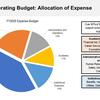Appropriation
The appropriation helps to offset Temple’s education-related costs, so we can pass those savings on to Pennsylvania students in the form of lower tuition. The annual state appropriation supports Temple’s core educational mission and uses the state funds to pay for the necessary expenses to educate students. Pennsylvania currently ranks 46th in funding per student for state appropriations to public universities where college in PA costs 28.33% more than the national average cost of attendance at a public 4-year institution (see Education Data report). According to the Commonwealth Foundation, PA ranks 23rd nationally in grants per all college students; and ranks 43rd for total state funding per public university undergraduate student. State lawmakers have not increased funding to Penn State, Pitt, or Temple since fiscal year 2020. Ahead of his first budget address, Governor Josh Shapiro released a new blueprint for higher education in Pennsylvania, focused on competitiveness and workforce development, and grounded in access and affordability.
Tuition
Temple approaches the tuition-setting process from the outset each year with a goal of keeping any increases as low as possible. That goal is dependent on a variety of factors, including enrollment estimates for resident and non-resident students; state appropriation; cost-saving opportunities; cost increases committed to labor contracts, and employee benefits. See the tuition calculator for a closer look.





